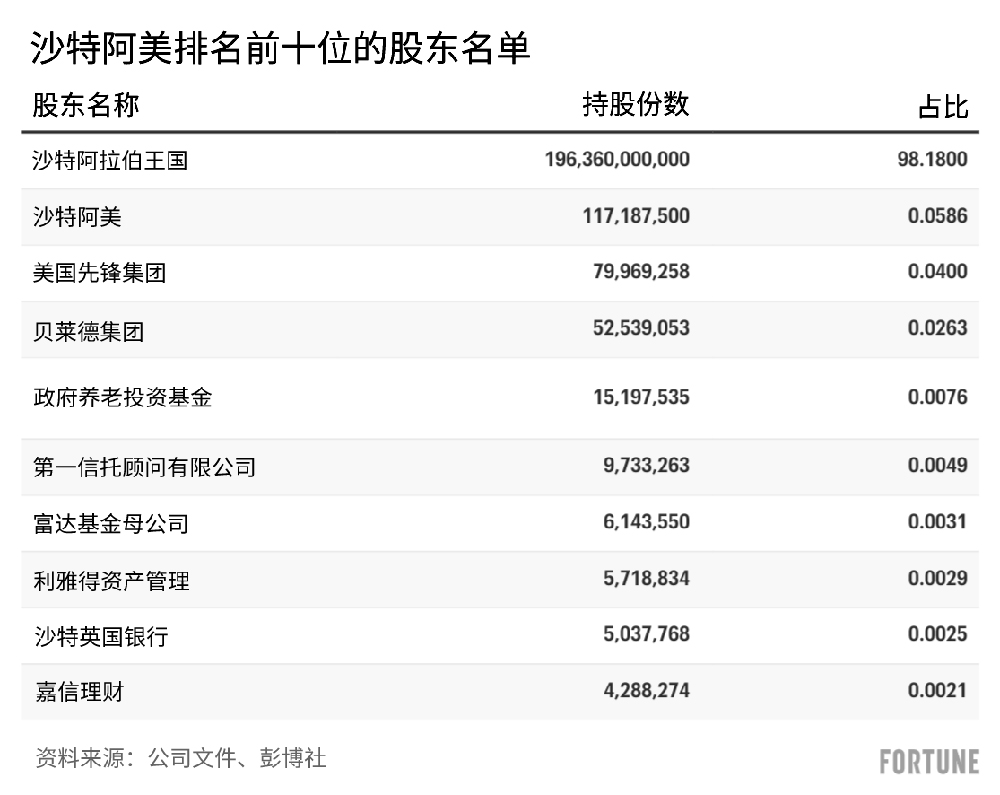2019年年底,一些投资者买入当时全球规模最大的一只首次公开发行的股票——沙特阿美(Saudi Aramco)的上市股票。他们本来满怀希冀期待大赚一笔。然而,这只股票却迟迟没有动静。
沙特阿美是世界上最大的石油生产商,市值达到1.85万亿美元,继续创造令人印象深刻的利润,但它的股票几乎没有变动,即使它宣布大力发展绿色能源,或者有小道消息称沙特阿美正在努力促成一笔数十亿美元的交易。
更糟糕的是,与竞争对手相比,它每个季度支付的股息看起来少得可怜。更不用说通过回购股票来提振股价。算了吧。流通股的规模如此之小,管理层几乎没有什么股票可以重新收购,更不用说引发股市反弹了。
8月25日,沙特阿美的收盘价格为34.80沙特里亚尔(约合9.28美元),今年迄今累计下跌0.1%。所造成的结果是:沙特阿美的投资者错过了今年能源股的大幅上涨。同期,标准普尔500指数(S&P 500)的能源板块上涨26.8%。
公平地说,去年新冠疫情导致全球石油需求大幅下降,能源股被大量抛售,而这些沙特阿美的投资者本来能够从中获得缓冲。尽管全球各大能源巨头的股价下跌,但沙特阿美岿然不动,全年几乎没有变动。然而,尽管全球经济保持增长以及石油需求的前景有所改善,但今年的油价仍然与去年持平。
孤立无援的“买入”评级
如果你喜欢获得无趣的、微小的收益,并且你需要购买股票,那么沙特阿美就十分适合你。
就连分析人士也认为这是一笔收益不大的投资。在涵盖沙特阿美的17家券商中,有一家评级为“买入”,一家评级为“卖出”,还有15家评级为“持有”。
伯恩斯坦公司(Bernstein)本月在一份投资者报告中说:“尽管沙特阿美的运营指标很好,但我们继续看到其他公司的价值更高。”这突显了沙特阿美4%的股息收益率与俄罗斯天然气工业股份公司(Gazprom)或卢克石油公司(Lukoil)等新兴市场能源股9%至10%的平均收益率之间的差距。伯恩斯坦对沙特阿美股票的评级为“逊于大盘”,目标价为24沙特里亚尔,较8月25日的收盘价低31%。
晨星公司(Morningstar)的股票分析师艾伦•古德认为,未来18个月左右,沙特阿美的股市前景仍然受到新冠疫情的影响。除此之外,他认为中国将处于更有利的地位,因为中国有能力生产大量廉价原油。与此同时,许多国际竞争对手正在减少对石油的投资,因为它们正在转向绿色能源。
“它们的生产成本是每桶3美元,所以如果(石油行业)只剩最后一个人,那将是沙特阿美。”古德如此说道。
“石油需求不会很快消失。”他补充道。
轻微浮动
不过,从短期来看,沙特阿美股票的基本面因素或将成为拖累。
从股权来看,沙特政府坐拥该公司超过98%的股份;沙特公民、机构以及一些华尔街企业分割剩下的“残羹冷炙”。

通过向持有该股达到6个月的股民提供10派1的福利,政府以此激励沙特散户投资者继续持有该股票。至关重要的是,沙特政府兑现了在2024年之前每年至少支付750亿美元股息的承诺,并保证在2024年之前向少数股东支付同等规模的股息,这意味着股票收益率在4%左右。
但是,与竞争对手相比,这笔支出仍然略显逊色。据伯恩斯坦公司称,埃尼集团(Eni)的股东预计收益率为7.7%,埃克森美孚(Exxon Mobil)和雪佛龙(Chevron)的数值则分别为6%和5.2%。卢克石油、俄罗斯天然气工业股份公司和俄罗斯石油公司(Rosneft)等新兴市场的石油巨头支付的回报要来得更高。
“我们持续地关注到,与沙特阿美不同的是,新兴市场和发达市场的股票价值更高。”伯恩斯坦公司在8月8日的一份投资者报告中写道。该报告强调了沙特阿美股票的“表现不佳”评级。
支付低额股息
此外,毫不意外的是,沙特阿美的管理层正在面临越来越大的压力,要求其效仿石油巨头的做法,提高股息支付(该公司几乎没有回购股票的空间),以争取新的投资者。
美银证券(BofA Securities)于本月表示,为了保持竞争力,“沙特阿美至少应该重新考虑其先前的计划,逐步增加股息,并向股东分配任何可能的额外现金流”。
根据美国银行(BoA)的预测,布伦特原油今年的价格为每桶68美元,明年则为每桶76美元,由此可推得,沙特阿美今年将产生950亿美元的自由现金流,2022年将产生1200多亿美元的自由现金流,从而产生提高股息的可能性。
在分析师电话会议上被问及股息政策时,沙特阿美的首席财务官齐亚德•阿尔-穆尔希德没有做出提高股息的承诺,但指出“公司一直以来都在分发特别股息”。
晨星公司的古德补充道,由于长期上涨的股票、相对不引人注目的业绩以及稳定的股息支付,沙特阿美的股票有点像债券。
与此同时,沙特王储穆罕默德•本•萨勒曼提出了政府出售更多沙特阿美股份的可能性。古德认为,从长远来看,一旦世界从新冠疫情中恢复过来,这有可能发生。
他认为,沙特政府可能会在沙特交易所出售更多沙特阿美的股票,同时放松对外国投资者购买的限制,紧接着,沙特阿美可能在国际市场上市,最有可能在亚洲。
但首先,沙特必须让投资者兴奋起来,争相购买。(财富中文网)
编译:於欣、杨二一
2019年年底,一些投资者买入当时全球规模最大的一只首次公开发行的股票——沙特阿美(Saudi Aramco)的上市股票。他们本来满怀希冀期待大赚一笔。然而,这只股票却迟迟没有动静。
沙特阿美是世界上最大的石油生产商,市值达到1.85万亿美元,继续创造令人印象深刻的利润,但它的股票几乎没有变动,即使它宣布大力发展绿色能源,或者有小道消息称沙特阿美正在努力促成一笔数十亿美元的交易。
更糟糕的是,与竞争对手相比,它每个季度支付的股息看起来少得可怜。更不用说通过回购股票来提振股价。算了吧。流通股的规模如此之小,管理层几乎没有什么股票可以重新收购,更不用说引发股市反弹了。
8月25日,沙特阿美的收盘价格为34.80沙特里亚尔(约合9.28美元),今年迄今累计下跌0.1%。所造成的结果是:沙特阿美的投资者错过了今年能源股的大幅上涨。同期,标准普尔500指数(S&P 500)的能源板块上涨26.8%。
公平地说,去年新冠疫情导致全球石油需求大幅下降,能源股被大量抛售,而这些沙特阿美的投资者本来能够从中获得缓冲。尽管全球各大能源巨头的股价下跌,但沙特阿美岿然不动,全年几乎没有变动。然而,尽管全球经济保持增长以及石油需求的前景有所改善,但今年的油价仍然与去年持平。
孤立无援的“买入”评级
如果你喜欢获得无趣的、微小的收益,并且你需要购买股票,那么沙特阿美就十分适合你。
就连分析人士也认为这是一笔收益不大的投资。在涵盖沙特阿美的17家券商中,有一家评级为“买入”,一家评级为“卖出”,还有15家评级为“持有”。
伯恩斯坦公司(Bernstein)本月在一份投资者报告中说:“尽管沙特阿美的运营指标很好,但我们继续看到其他公司的价值更高。”这突显了沙特阿美4%的股息收益率与俄罗斯天然气工业股份公司(Gazprom)或卢克石油公司(Lukoil)等新兴市场能源股9%至10%的平均收益率之间的差距。伯恩斯坦对沙特阿美股票的评级为“逊于大盘”,目标价为24沙特里亚尔,较8月25日的收盘价低31%。
晨星公司(Morningstar)的股票分析师艾伦•古德认为,未来18个月左右,沙特阿美的股市前景仍然受到新冠疫情的影响。除此之外,他认为中国将处于更有利的地位,因为中国有能力生产大量廉价原油。与此同时,许多国际竞争对手正在减少对石油的投资,因为它们正在转向绿色能源。
“它们的生产成本是每桶3美元,所以如果(石油行业)只剩最后一个人,那将是沙特阿美。”古德如此说道。
“石油需求不会很快消失。”他补充道。
轻微浮动
不过,从短期来看,沙特阿美股票的基本面因素或将成为拖累。
从股权来看,沙特政府坐拥该公司超过98%的股份;沙特公民、机构以及一些华尔街企业分割剩下的“残羹冷炙”。
通过向持有该股达到6个月的股民提供10派1的福利,政府以此激励沙特散户投资者继续持有该股票。至关重要的是,沙特政府兑现了在2024年之前每年至少支付750亿美元股息的承诺,并保证在2024年之前向少数股东支付同等规模的股息,这意味着股票收益率在4%左右。
但是,与竞争对手相比,这笔支出仍然略显逊色。据伯恩斯坦公司称,埃尼集团(Eni)的股东预计收益率为7.7%,埃克森美孚(Exxon Mobil)和雪佛龙(Chevron)的数值则分别为6%和5.2%。卢克石油、俄罗斯天然气工业股份公司和俄罗斯石油公司(Rosneft)等新兴市场的石油巨头支付的回报要来得更高。
“我们持续地关注到,与沙特阿美不同的是,新兴市场和发达市场的股票价值更高。”伯恩斯坦公司在8月8日的一份投资者报告中写道。该报告强调了沙特阿美股票的“表现不佳”评级。
支付低额股息
此外,毫不意外的是,沙特阿美的管理层正在面临越来越大的压力,要求其效仿石油巨头的做法,提高股息支付(该公司几乎没有回购股票的空间),以争取新的投资者。
美银证券(BofA Securities)于本月表示,为了保持竞争力,“沙特阿美至少应该重新考虑其先前的计划,逐步增加股息,并向股东分配任何可能的额外现金流”。
根据美国银行(BoA)的预测,布伦特原油今年的价格为每桶68美元,明年则为每桶76美元,由此可推得,沙特阿美今年将产生950亿美元的自由现金流,2022年将产生1200多亿美元的自由现金流,从而产生提高股息的可能性。
在分析师电话会议上被问及股息政策时,沙特阿美的首席财务官齐亚德•阿尔-穆尔希德没有做出提高股息的承诺,但指出“公司一直以来都在分发特别股息”。
晨星公司的古德补充道,由于长期上涨的股票、相对不引人注目的业绩以及稳定的股息支付,沙特阿美的股票有点像债券。
与此同时,沙特王储穆罕默德•本•萨勒曼提出了政府出售更多沙特阿美股份的可能性。古德认为,从长远来看,一旦世界从新冠疫情中恢复过来,这有可能发生。
他认为,沙特政府可能会在沙特交易所出售更多沙特阿美的股票,同时放松对外国投资者购买的限制,紧接着,沙特阿美可能在国际市场上市,最有可能在亚洲。
但首先,沙特必须让投资者兴奋起来,争相购买。(财富中文网)
编译:於欣、杨二一
In late 2019, investors buying into what was then the world’s biggest IPO—the listing of Saudi Aramco—would have been in their right to expect some fireworks. Instead, it’s been one big snooze.
The world’s top oil producer, worth $1.85 trillion, continues to churn out impressive profits, but its stock has barely moved, even when it announces a big push into green energy or news leaks it’s on the prowl for a multibillion-dollar deal.
Making matters worse, the dividend it pays out each quarter looks miserly when compared to rivals’. And hopes of a share buyback to goose the stock? Forget it. The float is so minuscule there are barely any shares for management to reacquire, let alone ignite a rally.
On August 25, Aramco closed at 34.80 Saudi riyals ($9.28), down 0.1% year to date. The upshot: Aramco investors have missed out on the great rally in energy stocks this year. In the same period, the S&P 500 energy sector was up 26.8%.
To be fair, those same Aramco investors would have been cushioned from last year’s brutal selloff in energy stocks when the COVID-19 pandemic decimated global demand for oil. While the world’s energy majors’ shares tanked, Aramco held its own, finishing the year barely changed. It’s flat again this year, however, even as the prospect for global growth and oil demand perk up.
One lonely “buy” rating
If you like boring, unremarkable returns, this is the stock for you—provided you can find any shares.
Even analysts see it as a two-scoops-of-vanilla investment. Of the 17 brokerages covering Aramco, there’s one “buy” rating, one “sell,” and 15 “holds.”
“While Aramco has great operating metrics, we continue to see better value elsewhere,” Bernstein said in an investor note this month, underscoring the gulf between Aramco’s 4% dividend yield and the 9% to 10% average yield on emerging-market energy stocks like Russia’s Gazprom or Lukoil. Bernstein has an “underperform” rating on Aramco stock and a target price of 24 riyals, a 31% discount from August 25’s close.
Allen Good, an equity analyst at Morningstar, sees Aramco’s prospects still being clouded over the next 18 months or so by the COVID pandemic. Beyond that, he thinks it will be in a stronger position because of its ability to pump huge quantities of cheap crude while many international rivals are reducing investment in oil as they transition to green energy.
“Their production cost is $3 per barrel, so if there’s going to be a last man standing (in the oil industry), it’s going to be Saudi Aramco,” Good said.
“Oil demand is not going away anytime soon,” he added.
Tiny float
In the short term, however, the fundamentals of the stock could be a drag.
The Saudi government owns more than 98% of the company; Saudi citizens, institutions, and a few Wall Street firms share the leftover scraps.
The government gave Saudi retail investors an incentive to hang on to the shares initially by offering a one-for-10 share bonus to those who held the shares for six months. And crucially, it’s living up to its promise to pay a dividend of at least $75 billion a year until 2024 and guaranteed a payout on that scale to minority shareholders until then, meaning the shares yield about 4%.
But that payout looks cheap when compared to rivals. According to Bernstein, Eni shareholders see an estimated yield of 7.7%, with Exxon Mobil and Chevron paying out yields of 6% and 5.2%, respectively. Emerging-market oil majors, such as Lukoil, Gazprom, and Rosneft, pay out an even higher return.
“We continue to see better value in EM [emerging market] and DM [developed market] stocks versus Aramco,” an Aug. 8 Bernstein investor note read in underscoring the firm’s “underperform” rating on the stock.
Paying (cheap) dividends
Not surprisingly, Aramco management is getting increasing pressure to follow the Big Oil playbook to raise dividend payments (it has little scope to buy back shares) in an effort to woo new investors.
BofA Securities said this month that to stay competitive, “Aramco should at least revisit its earlier plans to progressively increase the dividend and potentially distribute any additional windfall cash flows” to shareholders.
Based on BoA’s forecast of a $68 per barrel price for Brent oil this year and $76 next, Saudi Aramco would generate a free cash flow of $95 billion this year and more than $120 billion in 2022—giving it scope to raise dividends.
Asked about dividend policy on the analysts’ call, Aramco’s CFO Ziad al-Murshed made no commitment to raise dividends, but pointed out that “historically the company has distributed special dividends.”
With the long-term upside, the relatively unspectacular performance, and steady dividend payout, the Aramco share resembles something like a bond, adds Morningstar’s Good.
Saudi Arabia’s Crown Prince Mohammed bin Salman, meanwhile, has raised the prospect that the government could sell more shares in Aramco. Good thinks this is possible in the longer term, once the world has recovered from COVID.
He thinks the Saudi government could sell more Aramco shares on the Saudi exchange, while loosening restrictions on purchases by foreign investors, followed by a potential international listing, most likely in Asia.
But first the Saudis have to get investors excited enough to buy.






